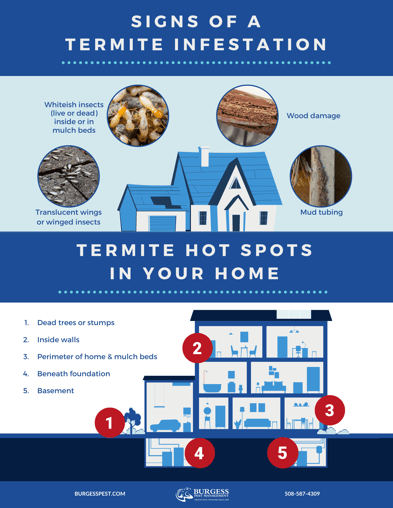Termites in Massachusetts typically swarm once per year, often on a warm spring day after a rainfall. Because they spend most of their time underground, swarm season may be the only time of year, and the only way, to know if you have a termite problem in your home - unless you know what other signs to look for.
[click to enlarge]
1. Translucent wings or winged insects. During swarm season, reproductive winged termites emerge from the ground to mate and seek ideal places to start a new colony. After mating, termite swarmers permanently shed their wings. Finding discarded wings or winged insects in or around your home is a good indicator of a termite infestation. (If you're seeing winged insects, learn how to tell the difference between flying ants and termites - or call a professional!)
2. Whitish insects inside or in mulch beds. Worker termites are pale and whitish in color, with a rounded head and straight antennae. While they may look a bit like a white ant, they have a broader body without the tell-tale "pinched waist" of an ant.
3. Wood damage. Termites consume wood 24 hours a day, and when they are making a meal of a home, this can cause the wood to bend, sag, or buckle. Unfortunately, termite damage can be difficult to identify until it is extensive. This damage can be easily confused with wood rot or water damage; if you find areas of concern, it's best to have a professional inspect your home for signs of an infestation.
4. Mud tubing. Mud tubes are long, thin tunnels that help to keep termites hydrated when traveling from the ground to a food source. They are generally about the width of a pencil, muddy-looking (no surprise there), and appear vein-like in their shape. You may see mud tubes along concrete foundations, beneath flooring, underneath siding, or in the basement.
Where to Look for Termites
It's all well and good to know the common signs of termites, but it isn't much help unless you know where to look for them..
1. Dead trees and stumps. If there is wet, decaying wood anywhere on your property, termites will do their best to establish their colony there.
2. Inside walls. Like many pests, termites can sneak inside your walls undetected. You may be able to hear them as they travel throughout your home, gnawing away happily.
3. Perimeter and mulch beds. This is a good place to look for mud tubes and live activity, which are strong signs that termites are making (or have already made) themselves at home.
4. Beneath foundation. Subterranean termites live underground and will often burrow beneath your foundation in search of food.
5. Basement. Basements are often easy for termites to access through very small cracks and crevices in your foundation. The dark, damp conditions and proximity to food sources are ideal for these tiny terrors.
The bottom line is, termites can be difficult to spot and even more difficult to eliminate - and when they cause billions of dollars of damage each year in the U.S. (which is usually not covered by homeowners insurance - yikes!), there's no time to waste if you suspect termites are dining on your domicile. Call the experts at Burgess Pest for the best Massachusetts termite control, guaranteed.



